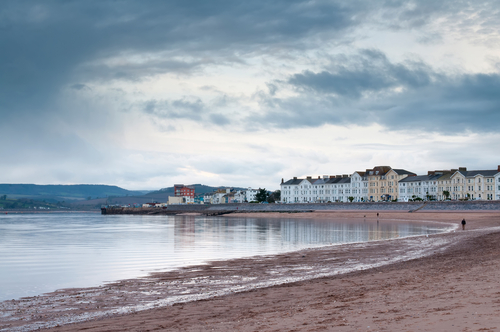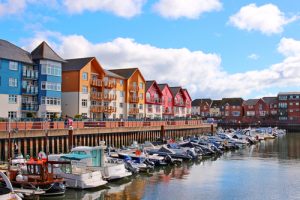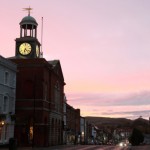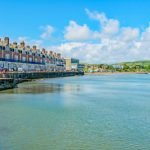
A quick guide to Exmouth
Exmouth is a port, civil parish and seaside resort situated on the east bank of the mouth of the River Exe, 11 miles (18 km) southeast of Exeter and at the western end of the Jurassic Coast World Heritage Site. Popularised during the 18th century, Exmouth has claims on being the oldest seaside resort in Devon. In 2011, at the time of the last National Census, Exmouth had a recorded population of 34,432, which made it the 5th most populous settlement in Devon.
A Fleeting History
Exmoor appears on a 13th-century Peutinger Map, a copy of an ancient manuscript that indicates there was a villa there during the Roman era. However, the 1970s find of 6th century Byzantine coins on the beach near Exmoor is the first physical evidence of any human activity in the area. The modern-day Exmouth parishes of Littleham and Withycombe Raleigh are thought to predate the arrival of the Saxons in the 7th century.
However, the first signs of any permanent settlement at the mouth of the River Exe cannot be traced back to any earlier than the 11th century. At that time Exmoor was known as Lydwicnaesse, translating as “the point of the Bretons’’. The town’s modern name is obviously derived from its location at the mouth of the River Exe estuary, with ‘exe’ being an ancient Celtic word for fish. In 1240, a quayside was built at Pratteshide, enabling Exmouth to develop as a fishing town. It was from the small harbour that the locally born Sir Francis Drake would set sail on several of his voyages.
Pirates
Between the early 16th and early 19th century, and especially during the 17th century, Exmoor, along with much of the southwest coast, suffered frequent raids by Barbary pirates. The pirates were often mistakenly referred to as ‘’Turks’’, even though they mainly operated out of the North African ports of Sale, Rabat, Algiers, Tunis and Tripoli, from what was then termed the ‘Barbary Coast’. Their quest was to capture white slaves and concubines for the Arab slave markets of North Africa.
The Barbary brigands also counted a few English and Dutch privateers among their ranks. The practice of white slavery didn’t end until America, with some help from its British And Dutch allies, managed to defeat and bring down the Ottoman Empire in the first (1801 – 1805) and second (1815) undeclared Barbary Wars.
18th Century Exmouth
The more tangible history of Exmoor does not begin until the end of the 18th century when it established itself as Devon’s first-holiday resort. Wealthy domestic tourists, no longer able to travel from Britain to continental Europe, due largely to the great social unrest in France, were attracted to the Exmouth area because of its pleasing scenic countryside and its supposed therapeutic sea waters.
In 1796, one of the town’s best-known landmark’s ‘A La Ronde’ was completed. The 16-sided house was commissioned by two cousins, Jane and Mary Parminter, members of a well-known and influential Cornish family. It is supposed by many that the unusual design of the house was based on that of the Basilica of San Vitale, a rare surviving 6th-century Byzantine church in Ravenna, Italy. Notable visitors to Exmouth around this time included Lady Byron and her daughter Ada Lovelace.
Lady Nelson, the estranged wife of Lord Nelson, took up residence at Exmouth shortly after the death of her naval hero husband at the Battle of Trafalgar in 1805. She was buried beside her son in the churchyard of St Margaret and St Andrew at Littleham, following her death in Harley Street, London in 1831.
Exmouth Gets a Lifeboat
In 1803, Exmouth got its first lifeboat. However, in 1814, a severe storm washed away the boathouse that stood near Passage House. In 1825, a new harbour was built to Exmouth’s great advantage, replacing the old tidal dock, the new permanent harbour could now be utilised much more efficiently. In 1858, the RNLI reintroduced a lifeboat service building a boathouse near the beachfront.
In 1861, the 11-mile (18 km) branch railway line connecting Exeter with Exmouth was completed by the London and South Western Railway (LSWR) greatly increasing the town’s connectivity. While up to that point, holidaying in Exmouth had largely been the preserve of the well-to-do, the coming of the railway was to be the catalyst for tourism by the masses. In the first five days of opening 10,000 people travelled on the line, the town’s property prices almost increased overnight.
Exmouth Docks
In July 1868, Parliament gave final approval for the Exmouth Docks Company to improve and refurbish the harbour. The planned works, which included the construction of a railway siding, linking the short distance between the docks and LSWR’s goods yard, were up and running within a year. The new facilities greatly enhanced the transportation of goods, mostly coal and fish, from the docks to their marketplace.
In 1903, the old RNLI boathouse was demolished in favour of a new one built on the same site to accommodate a larger lifeboat. And in the same year, a rail link from Exmouth to the small coastal town of Budleigh Salterton was opened. In 1909, locally well-known family and landowners, the Phears’, gifted land from Marpool Park to the townsfolk of Exmouth. The land which also included Marpool Hall was eventually renamed, ‘Phear Park’. In 1926, Exmouth Train Station underwent a major refurbishment.
During the Second World War, Marpool Hall was utilised to house evacuees, mostly from London. Later it was used to billet American servicemen, before D-Day Landings.
The Modern Era
Exmouth docks had always been an important facet of the town but by the 1970s were beginning to struggle with change in the shipping industry. However, in the mid-1980s, Greendale Haulage and Storage Company, owned by the local entrepreneurial Carter family bought up the docks and for a time managed to turn round the dock’s fortunes. However, as time progressed, it became apparent that the small docks would not be able to facilitate ships of ever-increasing size. In 1989, the death knell came when a survey of the docklands found that the dock walls were structurally unsound, making the complex unfit for commercial activity. In 1990, the 700-ton Star Libra was the last ship to set sail from Exmouth docks, before closure.

Exmouth’s Quay Estate and busy Marina. Photo credit: Phil Friar/Shutterstock.com
Tourist Town
Today, Exmouth’s economy is largely dependant on tourism. The former docklands area has been renamed the Quay Estate, which houses an impressive waterfront development of more than 300 houses and flats. The popular Exmouth Marina is also part of the redevelopment. However, Exmouth still retains a modest fishing fleet that also berth at the marina, alongside other working boats that ferry tourists on trips along the Jurassic Coast. The Exmouth Mussels Company also has its main offices at the dock.
Some of the big days in the Exmouth calendar include Exmouth Festival which is held every annually in late May/early June. The festival includes lots of music, arts, theatre and food. The town’s Kite Festival is held in August, which is obviously a great fun family day out. The ‘’Spirit of the Exe & Exmouth Mussel Festival’’ is a joint event held in September on Exmouth Beach that celebrates the local area, including the fantastic seafood. There are also the usual activities of music, street theatre and food stalls that accompany the event. And if you feel brave enough, you could always join those hardy souls for Exmouth’s Christmas morning swim, a tradition that started in 1970.
Getting tho Exmouth
By Road
Exmouth is only 8 miles from the M5, making access from just about everywhere in the country fairly easy. From Junction 30 (near Exeter) of the M5, turn south onto the A376. Exmouth is about 8 miles (13 km) straight ahead.
By Train
Getting to Exmouth by train is relatively straightforward. There is a frequent and speedy train service between Paddington London, or Bristol, to Exeter St David’s (see Exeter guide). There are frequent train services from Exeter’s St David’s and Central stations to Exmouth, with the journey takes around 25 minutes.
By Bus
The National Express coach system has a main interchange coach station at Exeter, from which it’s an easy journey to Exmouth. Stagecoach’s Gold 57 service runs between Exeter and Exmouth from early until late. There’s a bus around every 20 minutes, 7 days a week, with the journey taking about 30 minutes.
By Air
Exmouth is an 11-mile drive from Exeter airport, where there are air passenger services operate to a wide range of destinations.
Sport In Exmouth
Exmouth Town FC
Formed in 1933, Exmouth Town is an amateur football team that currently play in the Western League Premier Division. Nicknamed ‘The Town’, they play their home games at the Southern Road Ground.
Other
- Exmouth also has two amateur rugby union teams, Exmouth RFC and Withycombe RFC.
- Devon County Cricket Club play their Minor Counties Championship matches at the Maer ground.
Notable Exmouth Residents
Some notable residents that were born or have lived in Exmouth are:
- Ronald Frederick Delderfield (1912 – 1972) – renowned and prolific novelist and dramatist of the mid-20th century moved to Exmouth as a child.
- Pauline Collins OBE – born in Exmouth in 1940, is a famed actress of British stage, television, and screen.
- William Kyd (c. 1400–1453) – was a 15th-century English pirate, who operated with impunity out of Exmouth between the 1430s – 1453.
What’s the Jurassic Coast?
The Jurassic Coast is a World Heritage Site found along the English Channel on the South coast of England. It stretches from Orcombe Point at Exmouth to Studland Bay, near Swanage, in Dorset, a distance of some 96 miles (154 km). It was added to UNESCO’s List of World Heritage Sites in December 2001, becoming the UK’s only wholly natural such site.
At the site, coastal erosion has exposed an almost unbroken sequence of dramatic rock formation, that covers the geological Triassic, Jurassic and Cretaceous periods, of up to 250 million years ago. The area was initially a desert, but transformed to a shallow tropical sea and then to an ancient forest, as time progressed. The fossilised remains of the various creatures that once roamed the area, throughout the Mesozoic Era, have in most cases been exceedingly well preserved in the rocks, adding to the uniqueness of the site.
The Jurassic Coast has been recognised by UNESCO for the outstanding universal value of its rocks, fossils and landforms. The site is said to best viewed from the sea where the distinctive nature of the different rock stratum and formations become more apparent.
Things to see and do!
Exmouth is recognised as a regional centre for water sports, particularly kite surfing, kayaking and windsurfing. There are also spectacular walks and cycling routes in the area. as well as sites of historic interest to check out. Here are a few recommendations of the activities to do and things to see in and around Exmouth:
- RED Rock Leisure – based just outside Exmouth, provides equipment and instruction for water sport activities such as paddleboarding, kayaking, windsurfing and kitesurfing.
- A La Ronde – is a late 18th century, National Trust owned, unique 16-sided house with historic gardens, which lies on the northern outskirts of the town.
- Orcombe Point – is where you’ll find the Geoneedle, an impressive landmark constructed of the various rock types found along the Jurassic coastline. It commemorates the opening of the area as a World Heritage Site.
- Powderham Castle – built in 1390, the Castle is one of the county’s best known stately homes and gardens. It lies about 2.5 miles northwest of Exmouth across the Exe estuary.
- Exe Estuary Trail – is a 26-mile long mostly flat path used for both walking and cycling, runs from Exmouth to Dawlish along the banks of the Exe estuary.
- World of Country Life – a family-owned visitor attraction, which is a mix of museum, animals, play areas and entertainment. There are both outdoors and indoor areas.
- Exmouth Museum – located in the centre of the town, it has 3 galleries that house displays and exhibits, telling the history of the area.
- Beaches – there are 3 decent beaches within a few miles of Exmouth. Budleigh Salterton Beach is a long pebble beach. Exmouth Beach is a 2-mile long sandy beach adjacent to the town. Sandy Bay Beach is a privately owned 1/2 mile-long sheltered beach but allows free access to the public.
Where to stay?
There’s a decent choice of accommodation in and around Exmouth itself with the surrounding area offering, in particular, more high-end options. In Exmouth, expect to pay something around the following for accommodation for 2 adults sharing:
B&B/Guesthouse/Lodge: £70 – 120
Hotel: £100 – 150
Luxury Hotel: £150 – 250
So there you have it, our Five Minute Overview of the lovely seaside town of Exmouth! Before you go why not try one of our quizzes or have a look at some of our other location guides. Better still why not join our growing community it’s free and could be very rewarding going forward.





